Applications of cold atmospheric plasmas(CAPs) in agriculture: a brief review and the novel development of a radio-frequency CAP jet generator for plant mutation
Heping LI (李和平), Jing LI (李静), Xiting ZHAO (赵喜亭),Liyan WANG (王立言), Chuan FANG (方川), Nan SU (苏楠),Chong ZHANG(张翀),Yan XU(许言),Meng LV(吕萌),Mingjun LI(李明军),*and Xinhui XING (邢新会),,*
1 Department of Engineering Physics, Tsinghua University, Beijing 100084, People’s Republic of China
2 College of Life Sciences, Henan Normal University, Xinxiang 453007, People’s Republic of China
3 Biobreeding Research Center, Wuxi Research Institute of Applied Technologies, Tsinghua University,Wuxi 214072, People’s Republic of China
4 MOE Key Laboratory of Industrial Biocatalysis, Department of Chemical Engineering, Tsinghua University, Beijing 100084, People’s Republic of China
5 Center for Systems and Synthetic Biology, Tsinghua University, Beijing 100084, People’s Republic of China
6 Institute of Biopharmaceutical and Health Engineering, Tsinghua Shenzhen International Graduate School, Shenzhen 518055, People’s Republic of China
Abstract Cold atmospheric plasmas(CAPs)have shown great applicability in agriculture.Many kinds of CAP sources have been studied in agricultural applications to promote plant growth and cure plant diseases.We briefly review the state-of-the-art stimulating effects of atmospheric-pressure dielectricbarrier-discharge (AP-DBD) plasmas, after the direct or indirect treatment of plants for growth promotion and disease control. We then discuss the special demands on the characteristics of the CAP sources for their applications in plant mutation breeding.An atmospheric and room temperature plasma (ARTP) jet generator with a large plasma irradiation area, a high enough concentration of chemically reactive species and a low gas temperature is designed for direct plant mutagenesis.Experimental measurements of the electrical,thermal and optical features of the ARTP generator are conducted. Then, an ARTP-P (ARTP for plant mutagenesis) mutation breeding machine is developed, and a typical case of plant mutation breeding by the ARTP-P mutation machine is presented using Coreopsis tinctoria Nutt.seeds.Physical and agricultural experiments show that the newly-developed ARTP-P mutation breeding machine with a large irradiation area can generate uniform CAP jets with high concentrations of chemically reactive species and mild gas temperatures,and have significant mutagenesis effects on the Coreopsis tinctoria Nutt. seeds. The ARTP-P mutation breeding machine may provide a platform for systematic studies on mutation mechanisms and results for various plant seeds under different operating conditions in future research.
Keywords:cold atmospheric plasma,radio-frequency glow discharge,mutation,plant breeding,ARTP, agricultural application
1. Introduction
Cold atmospheric plasmas (CAPs) have received increasing attention because of their promising applications in several emerging novel fields, ranging from advanced materials surface modification [1-3] to biomedical engineering [4-6],microbial mutation breeding [7-15], and agriculture [16-19].Generally, the treatment methods for samples using various CAP sources can be divided into two types, i.e. direct treatment with the treated materials being located in the discharge region between the electrodes or the downstream of the discharge region (i.e. the plasma jet region) apart from the electric field, and indirect treatment which uses plasma-activated solutions as the acting mediators. Typical features of CAP jets include high electron energy,high concentrations of various chemically reactive species, low and controllable gas temperatures which can even be controlled close to room temperature, and convenient plasma generating processes with the removal of the complex vacuum system. These unique characteristics are essential for the treatment of heatsensitive biomaterials, e.g. living cells or tissues, biomedical materials,etc.Moreover,for biomaterials such as cells,which are sensitive to electric field shock and require stable and uniform plasma irradiation with a large area,the CAP jet is a preferable choice. A plasma jet always takes the form of a stable and controllable thin plume outside the confinement of the electrodes. Although the influences of the conducting or insulated properties of the treated materials on the discharge instability and inhomogeneity can be avoided, the CAP jets produced by different electrode configurations and/or operated under different conditions may have different characteristics and functionalities, and consequently, be suitable for different applications.This,in turn,has stimulated the fast development of CAP sources in the last few decades [20].
The emergence and rapid development of the CAP applications in agriculture-‘plasma agriculture’ [18]-shows that it is widely acknowledged that CAPs have great potential as an efficient green tool for plant growth promotion and plant disease control. Preceding studies have shown that after either direct or indirect CAP treatment of seeds or plant tissues under appropriate conditions,seed germination,growth yield,and tolerance of disease, can be significantly improved. The abundant chemically reactive species in CAPs,especially the reactive oxygen species(ROS)and reactive nitrogen species(RNS),are believed to play a significant role.
Up till now,most studies in plasma agriculture have been actively carried out using CAPs generated by atmosphericpressure dielectric barrier discharge (AP-DBD) plasma generators [20], which are usually driven by kilohertz power supplies due to their operating convenience and low capital cost, mainly focusing on the activation of plant seeds and tissues or the disinfection of plant pathogens. Little attention has been paid to the plant mutagenesis action of CAPs.On the other hand,the CAP jet produced using a coaxial-type plasma generator with a bare-metallic electrode configuration and driven by a radio-frequency (RF) power supply [8], has been proved to be effective for genome mutation of micro-organisms. Li et al reported that it was the chemically reactive species, instead of heat, ultraviolet radiation, intense electric field,and/or charged particles,that broke the double chains of the plasmid DNA after being treated by the RF CAP jet [8].Therefore,it is anticipated that the genome mutation of plants can be achieved using such CAP source. Here, two aspects need to be emphasized. (i) Besides the AP-DBD source and the RF CAP jet discussed above, other plasma sources including microwave discharge source [21-23], atmospheric pressure gliding arc discharge [24], transient spark discharge source [25] and streamer corona discharge source [26], can also be applied in plasma agriculture.Due to the length limit,we focus on the popular AP-DBD plasma source and the RF CAP jet in this review. Interested readers can refer to the references listed above about other plasma sources; (ii) since the RF CAP jet has been successfully and widely used in the mutation breeding of various micro-organisms[7-15]and has always been referred to as an‘ARTP’(atmospheric and room temperature plasma) jet to characterize the major features of such a gas discharge plasma source, and to ease the understanding for people from the biological field [7, 10, 13-15],we use the term ‘ARTP’ and ‘RF CAP’ equally hereafter in this review.
In this review,based on a brief discussion on state-of-theart investigations into plasma agriculture using AP-DBD plasmas, in section 2, the critical requirements for the CAP source features of their agricultural applications focusing on plant mutation breeding, are summarized. Then, in section 3,a novel ARTP jet generator for plant mutagenesis is presented, with the experimental measurements of the electrical,thermal and optical characteristics of the plasma jets. Some recent application examples of the mutation breeding of plant seeds using our newly developed ARTP-P (ARTP mutagenesis for plants) machine, with the ARTP jet generator as the core part, are also summarized in section 3. Finally, a brief conclusion, and some discussions on future research, are provided in section 4.
2. Review of state-of-the-art stimulating effects on plants by AP-DBD plasma treatment
Over the past few decades, CAP treatment has been found to be a pollution-free and economic method for the inactivation or disinfection of micro-organisms as a result of containing abundant ROS and RNS, such as O, O3, OH, NO and NO2,etc,instead of the thermal or etching effect caused by plasma treatment[27].In addition,owing to the very fast decay of the chemically reactive species, the risk of residues caused by plasma treatment can also be avoided. Therefore, CAPs are widely considered to be a replacement for the chemical reagents used to improve seed growth performance and ultimate yield, by direct plasma activation to the seeds [28-53],or to improve tolerance of disease by treating the plant seeds or leaves, due to the plasma inactivation of plant pathogens[54-57]. Besides direct plasma treatment, indirect treatment by exposing plants to plasma-activated water(PAW)[58-68]is also an efficient method in agricultural applications.
Mechanism investigations on the plasma-plant tissue direct/indirect interactions showed that, in addition to the plasma disinfection effects, interactions between the chemically reactive species in the AP-DBD plasmas and the plant tissues could not only help modify the surface characteristics [28,33, 38, 39, 44] but also influence the metabolism of the plants[25,38,39].The influences of the plasma operating parameters and action methods on the treatment results, e.g. seed germination rate, growth, yield and disease infection tolerance of plants,as well as the corresponding plasma action mechanisms,will be briefly reviewed in the following subsections.
2.1. Direct treatment
From the very first study of AP-DBD direct treatment on plants, seeds have been chosen as the preferred materials for the convenience of handling and to observe activation effects on plant growth after germination.Studies on the treatment of various kinds of plant seeds by AP-DBD plasmas have been conducted, including wheat, rice, tomato, etc. Two configurations, as shown in figures 1(a) and (b), are frequently employed for the treatment of seeds, i.e. the plate-plate electrode setup with seeds being put between the electrodes[32, 34, 36]. Figure 1(c) shows the use of a plasma jet by placing the plant seeds downstream from the plasma generator (an AP-DBD plasma generator) [33, 54, 56]. The configuration illustrated in figure 1(a),with a conveyer belt,is always applied when the treatment time is relatively short,e.g. several tens of seconds [32, 36], while the configuration illustrated in figure 1(b) is suitable for cases with a longer treatment time, e.g. a magnitude of several minutes [34].
The working conditions of the AP-DBD systems vary according to the specific requirements. The power inputs of the power supply range from a few Watts to several hundreds of Watts, considering different sizes of seeds. Regarding the selection of the feeding gas of the plasma reactors, air is the most frequently used gas[31,36,49-52,56]as a result of its easy accessibility, low cost and ability to generate ROS and RNS,which play an important role in the plasma treatment of plant seeds. Other gases, such as pure helium [34], argon[38, 53], nitrogen [37] or a mixture of several gases such as air, argon, water vapor, nitrogen, oxygen and helium[35,54,55],are also applicable.In addition,the flow rates of the plasma working gas also vary from 0.1 l min-1to several tens of l min-1,depending on the amounts and sizes of seeds.Another essential plasma operating parameter is the treatment time for living tissues, which should be carefully selected to optimize the treatment efficiency, and to prevent possible damage. Exposure to AP-DBD plasmas for a very short time cannot provide a high enough dose to result in significant influences on plant growth activation,but several studies have also reported that a treatment time that is too long could lead to negative effects on plant growth [28, 32, 33]. These experimental results showed that there existed an optimal treatment time to obtain the best plant growth performances or yield. Pawlat et al investigated the growth parameters of six groups of Lavatera thuringiaca L. seeds under different exposure times(0,1,2,5,10 and 15 min),and obtained seeds with the highest germination rates when the AP-DBD plasma treatment time was 2 or 5 min [33], as shown in figure 2. In addition, it was reported that even under saline and osmotic stresses, the AP-DBD plasma treatment was still capable of helping promote the seed germination rates of Arabidopsis thaliana seeds [49].
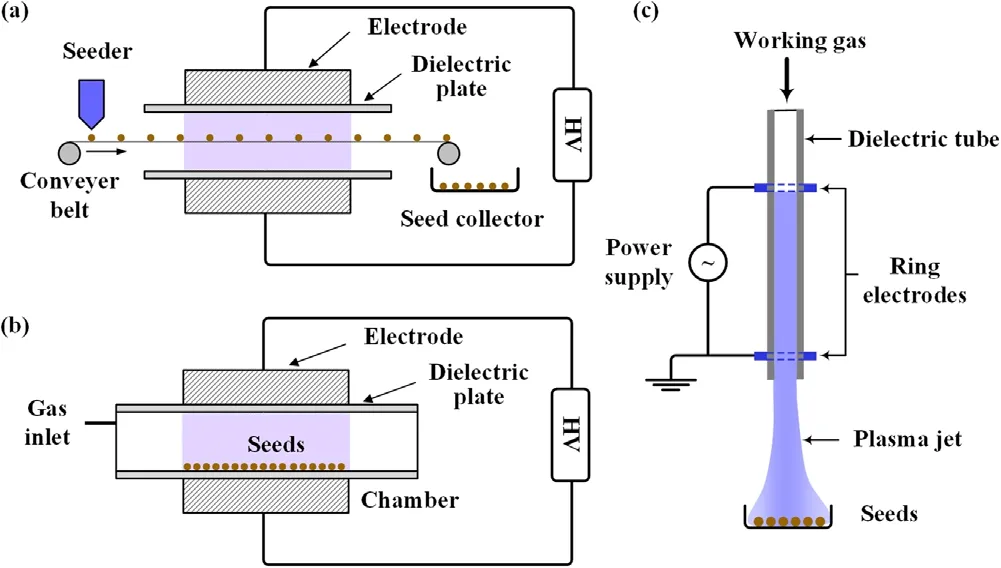
Figure 1.Schematics of typical AP-DBD plasma reactors used for treatment of plant seeds.
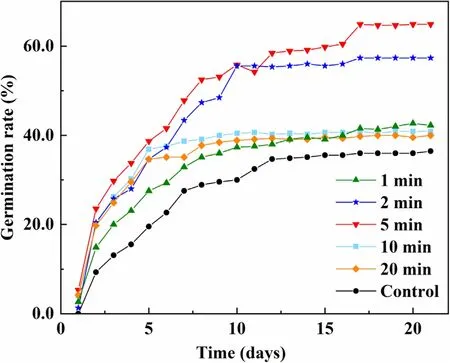
Figure 2.Seed germination rates of Lavatera thuringiaca L. seeds after being treated by AP-DBD plasma jets under different treatment times. Reproduced from [33]. CC BY 4.0. © 2018 Pawłat J et al.
The influences of AP-DBD plasma treatment on growth performances vary a lot between different studies.The results in [30] showed that, although the plasma treatment had little influence on the seed germination rate,it could help elongate the root and sprout. Kitazaki et al found that the maximum averaged Raphanus sativus L.seedling length of the AP-DBD plasma-treated seeds could be 250% longer than that of the untreated samples after the three-day cultivation [30].
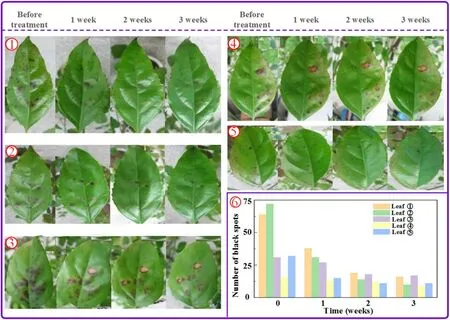
Figure 3.Initial symptoms of five fungus-infected leaves of P.erubescens cv.Green Emerald and advanced symptoms after plasma treatment for one to three weeks (①-⑤), and variations of the black spot numbers in leaves ①-⑤with plasma treatment time (⑥). Reprinted withpermission from [55]. Copyright (2014), AIP Publishing LLC.
Other parameters, e.g. the yield or weight of the crops,have also been studied by the researchers. For example, the seedling dry weight of Cicer arietinum could be improved by 120% after 1 min plasma treatment [28], while the fruit yield and weight were increased by 26.56% and 18.75%, respectively, compared with those of the control group after the 6 s AP-DBD plasma treatment under the discharge voltage of 6.12 kV [32]. Of course, there also exist negative examples.For example,a recent study showed that the plasma treatment of seeds did not show statistically significant differences in the yield of the corn harvested under realistic conditions,instead of under a laboratory conditions[42],and the authors believed that the results could be attributed to the already near-100%germination rate of commercial corn seeds and the use of the Poncho/VOTiVO protective coating on each sample.
AP-DBD plasmas have also started to be used for plant disease management in recent years, and are considered as a promising and effective method to replace the traditional ways such as chemical pesticides and hot water immersion,avoiding the risks of toxic resistance and environmental pollution, as well as the accumulated thermal damage to the plants[54].Zhang et al used a helium AP-DBD plasma jet for the surface treatment of fungus-infected plant leaves to control the spread of infection [55]. It was reported that, on the one hand, the plasma treatment was capable of inactivating the pathogen cells, and thus, controlling the spread of infection; while on the other hand, the plasma treatment had different healing effects on the five leaves as a result of the different sizes of the black spots infected by the fungal cells and the leaf ages,as shown in figure 3.In addition to fungusinfected diseases, Ochi et al found that the AP-DBD plasma treatment could selectively suppress the diseases infected by bacteria without affecting the germination rate and seedling growth of the healthy seeds [54]. However, for the antimicrobial effect on the tobacco mosaic virus, the AP-DBD plasma treatment could not completely kill it [56]. The virus particles could be disrupted by the plasma irradiation,but the viral coat protein subunit remained active, indicating that the plasma treatment could collapse the viral particles to the subunit level, degrade the tobacco mosaic virus RNA, and thus, lead to the loss of infectivity.
Based on the preceding discussions, we can see that the chemically reactive species in the AP-DBDs can act with the substances outside and inside of the plant cells,and there exist optimal working conditions for different kinds of seeds to obtain the best treatment results. Thus, it is important to investigate the AP-DBD plasma action mechanisms to obtain the desired plasma treatment results. Based on the present research results,the plasma action mechanisms on plant seeds can be summarized as follows.
(i) The decontamination of seeds can be achieved by APDBD plasma treatment, including the removal of microorganisms [16, 28, 43, 50], increasing the larval and pupal mortality of pests [44], which can keep the seeds clean during storage and sowing, and prevent possible diseases which are harmful to growth.

Figure 4.SEM images of the Lavatera thuringiaca L. seed surfaces, where (a) represents the control seeds, while (b) and (c) are the seeds treated by AP-DBD plasmas for 2 and 10 min, respectively. Reproduced from [33]. CC BY 4.0. © 2018 Pawłat J et al.
(ii) AP-DBD plasmas can modify the seed coats, leading to changes in the surface structures resulting from the complex actions of the chemically reactive species in plasmas [29, 30, 33, 34, 39]. The SEM images show clearly that the AP-DBD plasma treatment can make the seed surfaces disrupted,abraded and even loose from their original structures (figure 4) [33]. In addition, at the very early stage of germination, the capability of water absorption is considered to be one of the most significant factors triggering the transition from the quiescent state of the dry seeds to the metabolic reactivation of germinating seeds,and the water uptake is thought to be closely related to the structures of the seed surfaces.Many results showed that,after AP-DBD plasma treatment,the wetting properties of the seeds could be improved significantly. As shown in figure 5(a), Stolarik et al found that the water uptake increased when the treated seeds were immersed in water for two hours,but the longer imbibition time could cause a decrease in the dynamics of water uptake in treated seeds [39]. The dramatic decrease in the water contact angles of the seed surfaces due to the plasma modifications [33, 34, 39] has been reported by many studies. This is believed to be the main reason for the increase in water uptake of seeds.As shown in figure 5(b)[34],the surface of the fresh nasturtium seeds was partially hydrophobic with the apparent water contact angle close to 90°;while after 30 s plasma treatment,it became highly hydrophilic,with the apparent wetting contact angle lower than 30°.The highly hydrophilic surface would definitely be helpful for absorbing and accumulating more water in the seeds,and as a result,promoting seed germination and plant growth.

Figure 5.Changes in wetting properties after being treated by APDBD plasmas. (a) Changes in water uptake of pea seeds at 25 °C after different AP-DBD plasma treatment periods (60-180 s) [39];(b) water apparent contact angle of untreated and plasma-treated(30 s)nasturtium seeds in the outer part of the pericarp.Reproduced from [34]. CC BY 4.0. © The author(s) 2018.
(iii) The chemically reactive species in the AP-DBD plasmas can also influence the physiological and biochemical characteristics of the seeds in their early growth stage.On the one hand, Yanagawa et al found that with the aid of CO2or N2plasma treatment [45], protein was successfully introduced into the cells of the tobacco leaves.This result means that plasma treatment could be a useful technique for protein introduction into the plant tissues;while protein can act as nutrition and an enzyme during the growth of the plant tissues. On the other hand, both the activity and content of some important catalyzing enzymes and endogenous phytohormones, such as GA(gibberellic acid)[28],GABA(γ-aminobutyric acid)[52],IAA (indoleacetic acid) [39] and ABA (abscisic acid)[28, 41], as well as nitrites, nitrates[46] and nitric oxide[47],which are related to plant growth,can be influenced by the ROS and RNS in plasmas. It was reported that cytokinins [39], which could accelerate the development of seeds, and thiol compounds [40] which corresponded to the anti-oxidative activity of plants, increased after being treated by AP-DBD plasmas.Tong et al found that the AP-DBD plasma treatment could promote the CAT(catalase, EC.1.11.1.6) activity and expression, and simultaneously decrease the MDA (malondialdehyde)content in A. paniculata seedlings, which meant that the plasma treatment was beneficial to the plants in resisting environmental stress [36].

Figure 6.(a)Schematic of the cultivation setup,and pictures of Brassica rapa var.perviridis cultivated for 28 days by irradiation of control water with no plasma(b),and irradiation of 10 min(c)and 20 min(d)AP-DBD plasma-treated water per day.Reproduced from[58].©IOP Publishing Ltd. CC BY 3.0.
2.2. Indirect treatment - PAW
With direct treatment widely investigated and employed,negative effects have also been reported, such as the loss of original color, and the appearance of eroded plant surfaces due to the etching and degradation of bioactive compounds after the AP-DBD plasma direct treatment [33, 48]. Therefore,in order to ensure the biological activities and treatment efficiencies of some highly sensitive plant tissues to plasmas,the PAW based on the discharges underwater [25, 58, 59] or the plasma-liquid interface actions[62]is employed for plant irrigation. It is known that the PAW can create an acidic environment which leads to changes in the redox potential,electrical conductivity, pH value and the formation and concentration of multiple ROS and RNS [67-72],synergistically influencing the physicochemical properties of the PAW.
In actual applications, certain parts of the plants, such as the seeds or roots,are usually emerged in the PAW for hours or days. The experimental studies show that PAW has a synergistic effect on the decontamination of plants [21] and promotes their growth [60], which is similar to that of direct plasma treatment.
PAW can be obtained with tap/deionized water[25, 26, 69, 70, 73], drainage water from pots [58, 59] or nutrient solution [63, 64, 73] as the plasma-activated liquid.Since PAW contains species like H2O2, its pH value is usually below 7.0.It was reported that PAW with a pH value lower than 4.7 could effectively inactivate the bacteria,while if the pH value was higher than 4.7,the bacteria would hardly be affected[74].In addition,the conductivity of water is also strongly influenced by the discharges. For distilled water, its electrical conductivity usually varies between 0.5 and 3 μS cm-1, while the conductivity of the distilled water can reach 450 μS cm-1after activating with the Ar/O2plasma jet for 20 min due to the generation of the reactive ions [65].Another attractive and significant feature of the PAW is the abundant gaseous and aqueous ROS and RNS, among which hydrogen peroxide and nitrates are considered to be the most effective species for plant treatments [25]. The type and concentrations of the reactive species and the involved chemical reactions in the PAW depend on many factors including plasma forming gas, liquids, plasma-excited power supply,discharge mode, etc. The related research has become a hot topic because the reaction mechanisms are crucial to understand the nature of PAW and to help control the treatment effects in actual applications. For more details on PAW,interested readers can refer to some recent topical reviews,e.g. [60, 67, 75].
At present, the enhancing effects of PAW treatment for seed germination have been widely considered to be feasible.Naumova et al found that after being irrigated by water with five-minute-long plasma activation in advance, the germinability of the rye seeds increased by 50% [62]. Zhang et al reported similar results with a germination rate increasing from 30%to 80%[63].Takaki et al also reported the positive effects of PAW treatment on plant growth [58], as shown in figure 6.In addition,it seemed that with irrigating water,after longer plasma irradiation (e.g. 20 min) per day, the enhancements of the leaf size and plant height could be obtained, which was possibly attributed to the passing of some important nutrients to the plants by the PAW.Takahata et al reported that after the irrigation of PAW produced by the bubble discharges in water [66], both the plant heights and dry weights increased, which was related to the formation of nitrate nitrogen in the PAW and the absorption by the plant roots as a nutrient. As can be seen from figure 7, the cultivation of PAW had clearly different influences on plant growth, depending on both the kinds of plants and the discharge time to generate the PAW.
Up to now, the mechanisms of the interactions between PAW and plant tissues have not been completely revealed due to the great complexities of numerous possible physical and chemical processes during the PAW treatment, although many important studies have been reported.Some preliminary studies show that:

Figure 7.Influences of PAW cultivation on plant heights of(a)R.sativus var.sativus and(b)S.oleracea,as well as(c)on the dry weights of R. sativus var. sativus and S. oleracea at 28 days after PAW cultivation [66].
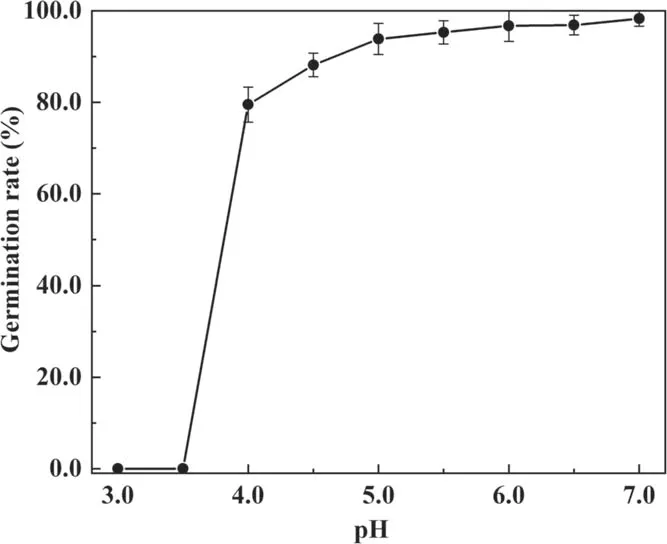
Figure 8.Influence of pH value of PAW on the germination rate of P. tomentosa seed after 14 days of cultivation [76].
(i) The pH value of the irrigation water has significant influences on the seed germination rate for some certain plants [76]. As shown in figure 8, the germination rate of the P. tomentosa seeds decreased sharply when the pH value of the environmental liquid was lower than 4.Though this effect may be rather different for different kinds of plants, it is still necessary to consider and control the pH values of PAW before the cultivation of different plants.
(ii) PAW treatment can also improve the protein content in the plant. As a significant nutrient, protein content is considered to be one of the standards to judge the quality of crops.Soluble proteins play an important role in plant growth and are also important components of numerous plant enzymes. As can be seen from figure 9[25],the soluble protein content of wheat root increased remarkably under different PAW treatment conditions;while for the above-ground part, a smaller increment was observed.In addition,it was found that the activity of the antioxidant enzymes, such as CAT, superoxide dismutase (SOD) and guaiacol peroxidase (G-POX),also increased after the PAW cultivation,indicating that the chemically reactive species in PAW could influence the growth signaling pathways of the plants [25].

Figure 9.Soluble protein contents in the wheat root and aboveground part four weeks after cultivation with tap water(control)and plasma-activated tap water (0.5 ml min-1, 2 ml min-1) [25].
A recent study by Liu et al summarized the putative mechanisms that could explain the promoting effects of PAW on seed germination[35],as shown in figure 10,in which the ROS and RNS played different roles in accelerating the seed germination. With the aid of ROS, the water absorption ability of seeds was promoted. This further triggered the enhancement of the biological metabolism inside the seeds in terms of various enzyme performances, which was beneficial in breaking the dormancy and speeding up the germination.Simultaneously, the RNS could also enhance the signaling molecules by regulating the endogenous hormones, namely ABA and GA, which jointly controlled the seed dormancy and germination. ABA is a positive regulator of dormancy induction and a negative regulator of germination; while GA releases dormancy,promotes germination and counteracts the effects of ABA [77]. Therefore, we can conclude that the existence of the ROS and RNS in PAW is beneficial in promoting the early growth of plants.
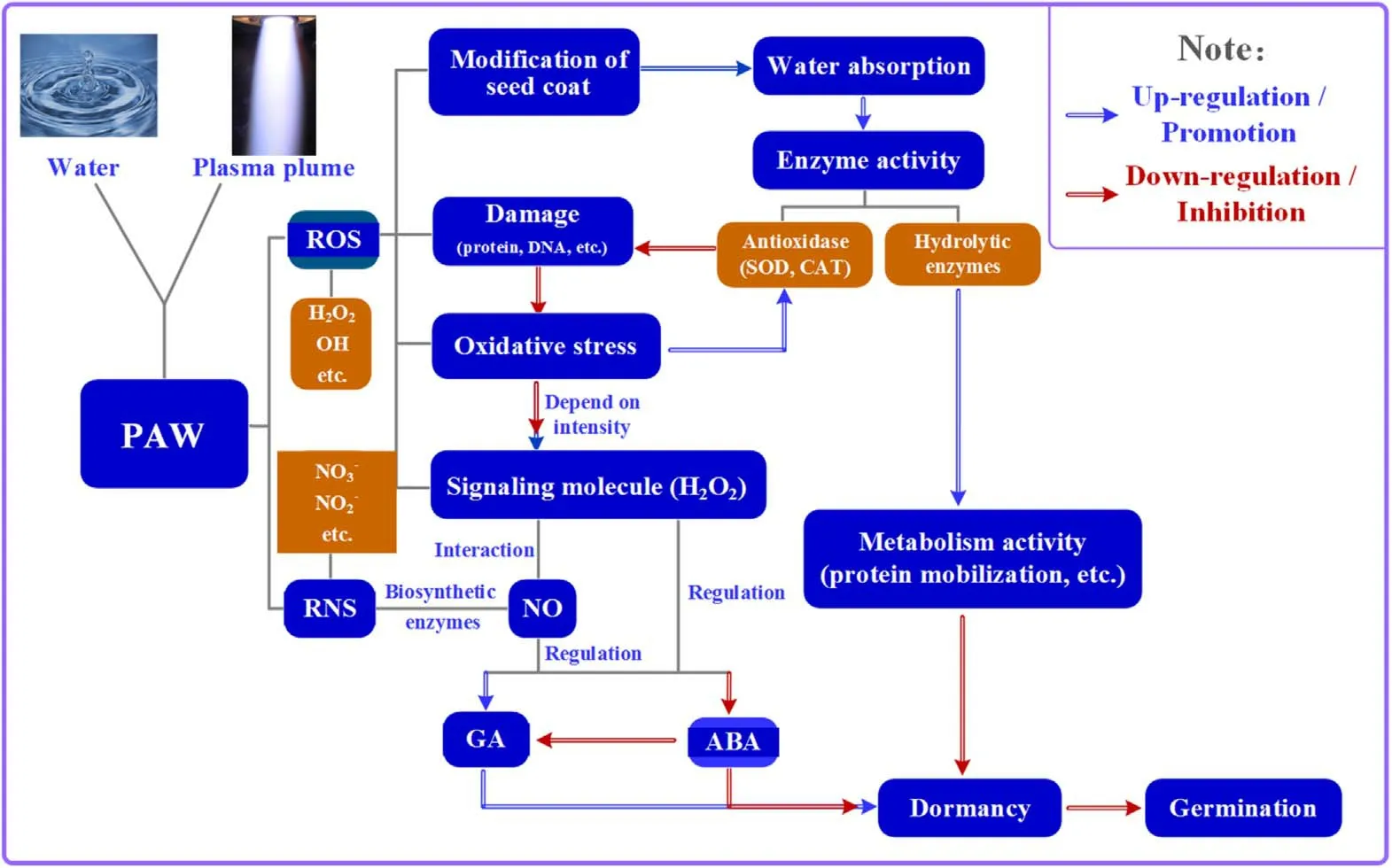
Figure 10.Schematic of the assumed PAW action mechanisms on the seed germination [35].
3. Plant mutation breeding using ARTP-P
3.1. Requirements of CAP generators for plant mutation breeding
As discussed in section 2, with the aid of the most widely employed AP-DBD devices, the active stimulation effects of plant seeds are obtained after direct or indirect plasma treatment. However, inevitable limitations also emerged in the AP-DBD sources.All these reported applications of AP-DBD plasmas for plants were based on the activation of plant seeds or tissues, rather than aiming at the genetic mutation for creating new phenotypes of plants. In addition, the high voltage(usually several thousands of volts)triggering the APDBDs and the discharge inhomogeneity caused by the plant seeds/tissues located between the electrodes can cause serious damage to the plant seeds or tissues; while the small irradiation area of the AP-DBD plasma jet also limits the treatment efficiency.
The so-called ARTP microbial mutagenesis machine driven by an RF power supply,as discussed in section 1,has been successfully employed in microbial mutational breeding for more than 100 kinds of microorganisms with much lower discharge voltage (usually several hundreds of volts) and plasma jet irradiation area of around 1 cm2[7, 14], which is enough for the treatment of microbial cells. The mechanism study has revealed that ARTP can cause strong DNA damage in living microbial cells, and then result in a high mutation rate per generation compared with traditional chemical and physical mutagens [7]. A recent study by Hui et al investigated low-pressure plasma treatment effects on wheat seeds[78]. They treated the seeds in the first generation and harvested them to get the second generation. Then, the third generation was obtained in the same way.The results proved that the biological characteristics and yield components of the wheat seeds exhibited a consistent trend from the first generation to the third generation, indicating that the plasma treatment could lead to genetic change in plants.Therefore,it is expected that the ARTP mutagenesis technology can be used to develop the plant mutation breeding method.The key challenge for developing ARTP plant mutagenesis is how to uniformly scale up the irradiation area of the plasma jets to flexibly treat a large number of plant materials including seeds,pollens and tissues. Therefore, to promote the actual applications of the CAP jets in plant mutagenesis for agriculture,a new ARTP generator needs to be developed first to produce plasma jets with a large area(e.g.several tens of square centimeters),a low gas temperature, high electron temperature (Te) and high concentrations of chemically reactive species,and the discharge should be uniform and stable. Based on the requirements, a highly-integrated mutagenesis machine, which is the so-called ARTP-P with the RF CAP generator as the core part, is developed for plant mutation breeding.
3.2. Physical features of the large-area RF-CAP jet
Based on the requirements stated in section 3.1,it is believed that the RF CAP jet discussed previously may be an appropriate option for plant mutagenesis in agriculture. Compared with the AP-DBD plasma sources discussed in section 2, the RF CAP source has some unique features as listed in table 1.To meet the requirements summarized in section 3.1, a newly-designed plasma generator with a multi-plate electrode configuration is proposed. As shown in figure 11(a), the connector to the RF power supply, the gas inlets and the cooling water inlet/outlet are arranged outside the shell of the generator, while the major components inside the shell include the homogeneous flow film which can make the gas flow uniformly between the powered and grounded electrodes, supporting boards for separating the electrodes and sustaining other parts, and water tube adaptors which help cooling water flow through the electrodes.Nine pairs of baremetallic plate electrodes are arranged to form a ‘sandwich’structure to produce a large-area quasi-uniform RF glow discharge plasma jet. The 2D electrode configuration is illustrated in figure 11(b) to show the powered and grounded electrodes clearly. The gap spacing between two adjacent electrodes is 1.0 mm. A typical discharge image is shown in

Figure 11.Schematics of the newly-designed RF CAP jet generator(a), the 2D electrode configuration (b), typical discharge image (c),and the experimental setup used for measurements of the electrical and optical features of the discharge plasmas (d).
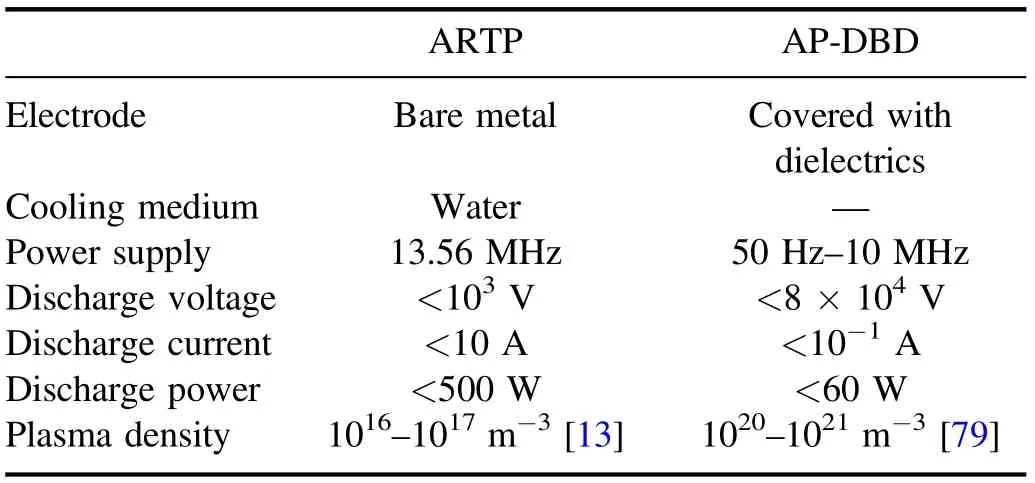
Table 1.Comparison of ARTP source and AP-DBD plasma source discussed in section 2 [28-57].
figure 11(c) with a plasma area of 6.7×5.8 cm2.
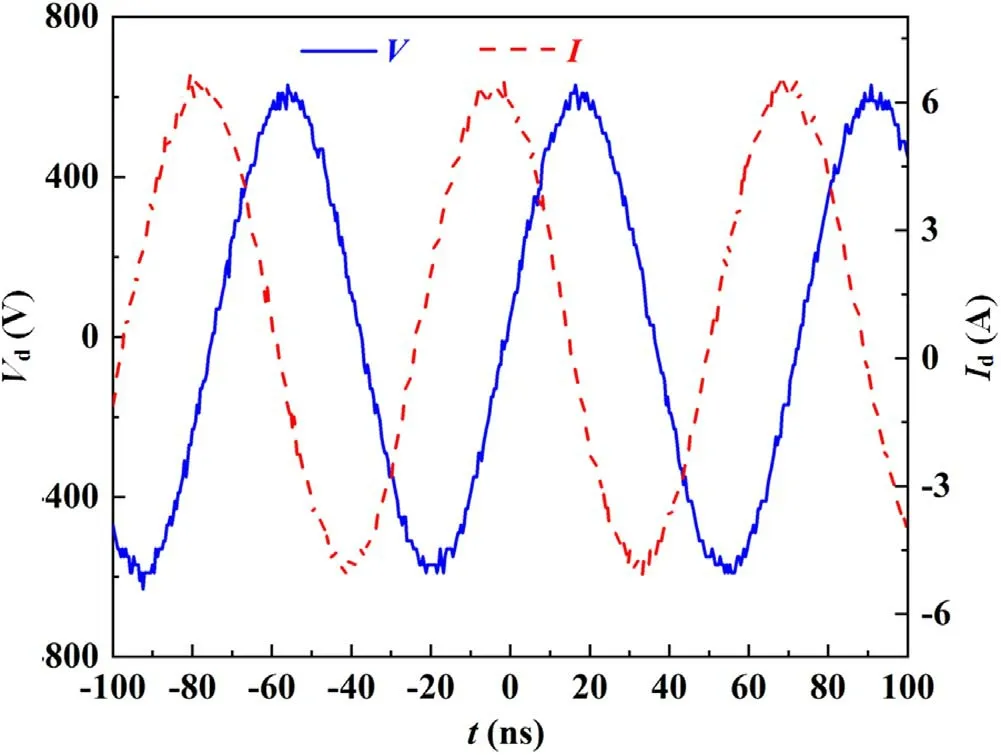
Figure 12.Waveforms of the discharge voltage and current(QHe=15 slpm, Pin=400 W, Tcw=283 K).
The experimental setup employed in this section to study the electrical and optical features,is shown in figure 11(d).The plasma working gas (helium with a purity of 99.999%) is introduced into the gas storage chamber through two gas inlets,and then,flows out of the chamber through the spaces between the electrodes. The copper electrodes are cooled by the deionized water from a water chiller (BLK II-5FF-B, Beijing ZhongHeChuangYe Science&Technology Development Co.,Ltd) with a fixed inlet temperature of Tcw=283 K. The RF power input is monitored and measured by a Z-scan(Advanced Energy Industries, Inc., Type 3155135-003).
Under the operating conditions of helium flow rate QHe=15 slpm,power input Pin=400 W and Tcw=283 K,the electrical characteristics of the discharges are measured using a digital oscilloscope (Tektronix DPO4034) with a current probe (Tektronix TCP0030A) and a voltage probe(Tektronix P6015A).The waveforms of the discharge voltage(Vd) and current (Id) are shown in figure 12. It is seen that,although there exist some small peaks in the curves of the discharge voltage and current,the forms of Vdand Idare both close to the sinusoidal form [80]. In particular, there are no very obvious sharp peaks for the current waveform in each cycle. This is very different from the DBDs in which sharp current peaks indicate the existence of micro filaments in the discharge region [80, 81]. The discharge voltage is much smaller than that of DBDs, avoiding possible electrical damage to the seeds during plasma mutagenesis.
It has been proved numerically that there exist various kinds of reactive species in the ARTP jet produced by a bare-metallic electrode configuration and driven by an RF power supply[82].Under the same working conditions as those in figure 12, the optical emission spectrum is recorded by a spectrometer(Avaspec Multi-Channel Spectrometer, Avantes) using an optical fiber, as shown in figure 13. During the experiments, the optical fiber is located on an assembled 3D precision translational stage (LXY40-CL, Dongguan Songfei Optoelectronics Technology Co.,Ltd and GCM-150104M,GCM-1711M,China Daheng Group,Inc.)and kept 2.0 mm away from the generator outlet. It can be seen that there are different kinds of ROS and RNS in the plasma jet region, e.g. excited helium and oxygen atoms, nitrogen molecules, hydroxyl, and nitrogen molecular ions, due to the strong interactions between the plasma mainstream and the surrounding air [83].

Figure 13.Typical optical emission spectrum from the RF CAP jet region 2.0 mm away from the generator exit (QHe=15 slpm,Pin=400 W, Tcw=283 K).
As stated in section 3.1,the spatial uniformity of the key parameters of the ARTP jets, including the gas temperature(Tg), electron temperature (Te) and the chemically reactive species concentrations, is quite important for characterizing the features, as well as for promoting the agricultural applications. Under the same working conditions as stated above,the intensity distributions of several typical emission lines(OH-309.72 nm, O-844.63 nm and N2-337.13 nm) on the plane[Plane B in figure 14(a)]2.0 mm away from the exit of the plasma generator (Plane A in figure 14(a)) are shown in figures 14(b)-(d). It is seen clearly that: (i) the spatial distributions of the optical emission intensities of O-844.63 nm and N2-337.13 nm have a similar variation trend in general,i.e.the maximum species emission intensities mainly locate at the central part of Plane B, and decrease toward the edge of the plane(figures 14(c)and(d)),while the spatial distribution of the optical emission intensities of OH-309.72 nm is somehow different with two emission intensity subpeak points as shown in figure 14(b). It is widely known that the generation of ROS in CAPs is closely related to the water vapor concentration in the feed gas and the background air,as well as the gas flowing (residence time) [84]. Moreover, the governing chemical reaction pathways have remained unclear up to now. Therefore, it is too complicated to explain the different spatial distribution of the OH emission intensity.However, we can still draw a conclusion that, in the central part of the plasma generator, the radiations of the chemically reactive species are stronger. (ii) The maximum relative discrepancies among the species’ optical emission intensities on Plane B are all smaller than 18.1% for the preceding three species. This means that the spatial distributions of the chemically reactive species downstream of the plasma generator are nearly uniform.
Correspondingly, the spatial distributions of the gas temperature and electron temperature on Plane B in the plasma jet region are also measured.The gas temperature(Tg)is measured after the discharges are sustained steadily for 30 min using a thermocouple (WRNK-191, Yanli Automatic Instrument (Shanghai) Co., Ltd) located on the precision translational stage by replacing the optical fiber probe in figure 14(a). While the electron excitation temperature (Texc)is calculated based on the Boltzmann plot [85]:

where Iijis the experimentally recorded emission intensity of the transition from level i to level j, kBis the Boltzmann constant,Eijand Aijare the energy difference and the Einstein coefficient for the spontaneous emission between the excited levels of i and j, λijis the corresponding wavelength of the emission line, giis the statistical weight of the level i, which can be obtained from NIST [86]. This method has been widely employed by researchers when studying medium-and high-pressure plasmas [87-89]. Due to the similar variation trends of the electron temperature(Te)and electron excitation temperature (Texc) at higher operating pressures [85], we intend to use Texcto characterize the variation trend of Te,i.e.Te=Texc, with an assumption of a Maxwellian electron energy distribution for the RF CAPs studied in this work.The helium lines at 667.81, 706.51 and 728.13 nm are employed for determining the values of Te. The spatial distributions of Tgand Teon Plane B are shown in figures 14(e) and (f),respectively. The experimental results show that: (i) the maximum gas temperature is 315.4 K which is low enough for avoiding the thermal damages to the plant seeds during plasma treatment; and (ii) there also exist uniform distributions for Tgand Tewith the maximum relative discrepancies of 2.5% and 4.1%, respectively.
3.3. Development of novel ARTP prototype for mutation breeding of plant seeds and a typical example
Based on the preceding studies of the thermal, electrical and optical characteristics of the RF CAP jet, a prototype called ARTP-P with the multi-plate-electrode generator as the core part, has been developed by collaborating with Wuxi Tmaxtree Biotechnology Co., Ltd, as shown in figure 15(a). After opening the cap of the ARTP-P mutagenesis machine, the desired amount of plant seeds can be put on the horizontal platform below the exit of the plasma generator.The distance between the plasma generator outlet and the treated seeds can be determined by the adjustor on the machine control panel.Then, after setting the flow rate of the working gas, starting the water chiller and triggering the power supply, the seeds start to be treated by the ARTP jet.
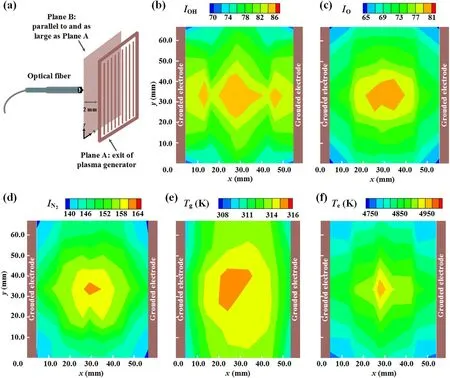
Figure 14.Illustration of the measurement of species emission intensities on Plane B, which is located 2.0 mm away from the exit of the plasma generator (a), spatial distributions of the species optical emission intensities (b)-(d), and those of the gas (e) and electron (f)temperatures on Plane B(QHe=15 slpm,Pin=400 W,Tcw=283 K).Here,the symbols IOH,IO,and IN2 represent the emission intensities of the emission lines OH-309.72 nm, O-844.63 nm and N2-337.13 nm, respectively.
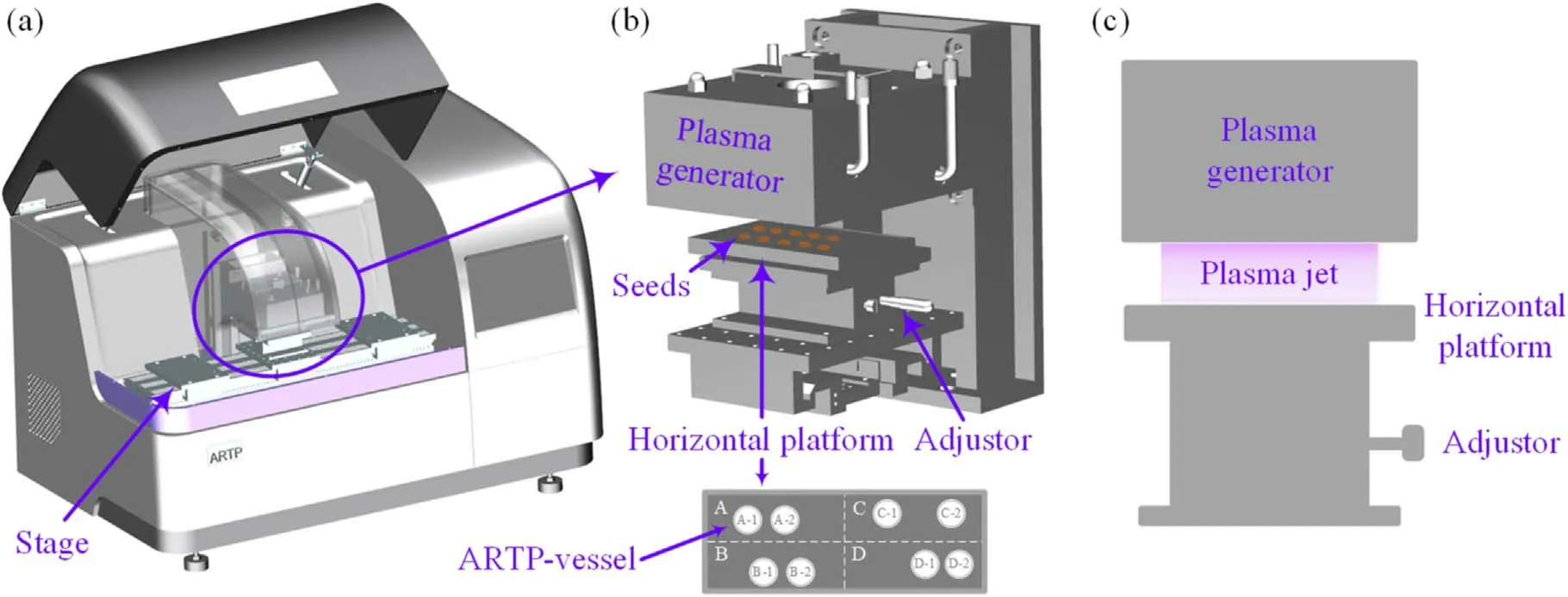
Figure 15.(a)Picture of the ARTP-P mutation machine for the treatment of plant seeds,(b)key part of the ARTP-P machine and distribution of the seeds or eight vessels on the horizontal platform, and (c) sideview schematic of the key part while treating the seeds.
To further prove the homogeneity of the biological effect after the ARTP treatment,mortality tests of Escherichia coli are conducted. In total, nine small vessels with a diameter of 8.0 mm, each containing the same LB liquid medium and bacteria inoculum, are employed. The concentration of the bacterial suspension is 106-108ml-1,and 10 μl is evenly daubed on each vessel.The horizontal platform below the plasma generator exit is as large as the plasma area and uniformly separated into four parts,i.e.A,B,C,D.As shown in figure 15(b),two vessels are randomly distributed in each part to be treated by the ARTP jetas the ARTP-vessels, and the ninth vessel is not treated as a control. A sideview schematic of the key part of the ARTP-P machine is shown in figure 15(c)which illustrates a clear relative position when treating the plant seeds.Under the same operating conditions as those in figures 12-14,the Escherichia coli cells in eight vessels are all treated for 252 s. After the ARTP jet treatment, the eight ARTP-vessels are transferred to eight Eppendorf tubes containing 1 ml sterilized water for each.After that,the Eppendorf tubes with vessels are shaken for 1 min and diluted,and then spread on the LB solid medium to measure the CFU (cell forming unit) to evaluate the cell mortality after the ARTP treatment. The CFU on the solid medium cultured at 37°C is NARTP.The control group is also prepared under the same conditions with no ARTP jet treatment(Nc).The mortality rate of Escherichia coli by the ARTP treatment can be calculated as:

Table 2.Mortality test results of Escherichia coli after the ARTP jet treatment.

To obtain a reliable conclusion,two rounds of experiments are conducted under the same treatment conditions as stated above. The experimental results are shown in table 2. The identifiers in table 2 are named according to the positions of the vessels on the platform,for example,A-1 and A-2 represent the first and second vessel in part A, respectively, as shown in figure 15(b). We can see from table 2 that: (i) the number of CFU without ARTP jet treatment is 5.7×105for both rounds;
(ii)the mortality rates of Escherichia coli range from 83.51%to 90.35%, and the maximum discrepancies in the same round never exceed 5.1%.This indicates that the ARTP jet treatment may have a homogeneous biological effect because the differences among the treated biological materials are negligible.
Thus, there is one issue we hope to emphasize here. In general,the uniform CAP treatment effects of plant seeds and the high consistency are mainly related to two aspects. The first one is the physical aspect, i.e. the CAPs used for seed treatment should have uniform characteristics,which has been proved by the thermal and optical measurement results of the large-area CAP jet produced by the new ARTP generator presented in section 3.2. The other is the seed aspect such as appearance, shape and size, etc. Previous results have shown that even the same CAP sources showed different treatment effects for different seeds [29, 35], which might be attributed to the different seed shapes and sizes.Therefore,it is essential to ensure the high consistency of CAP treatment of different seeds in actual applications, which forms an important research aspect in plasma agriculture and will be conducted in detail in our future work.
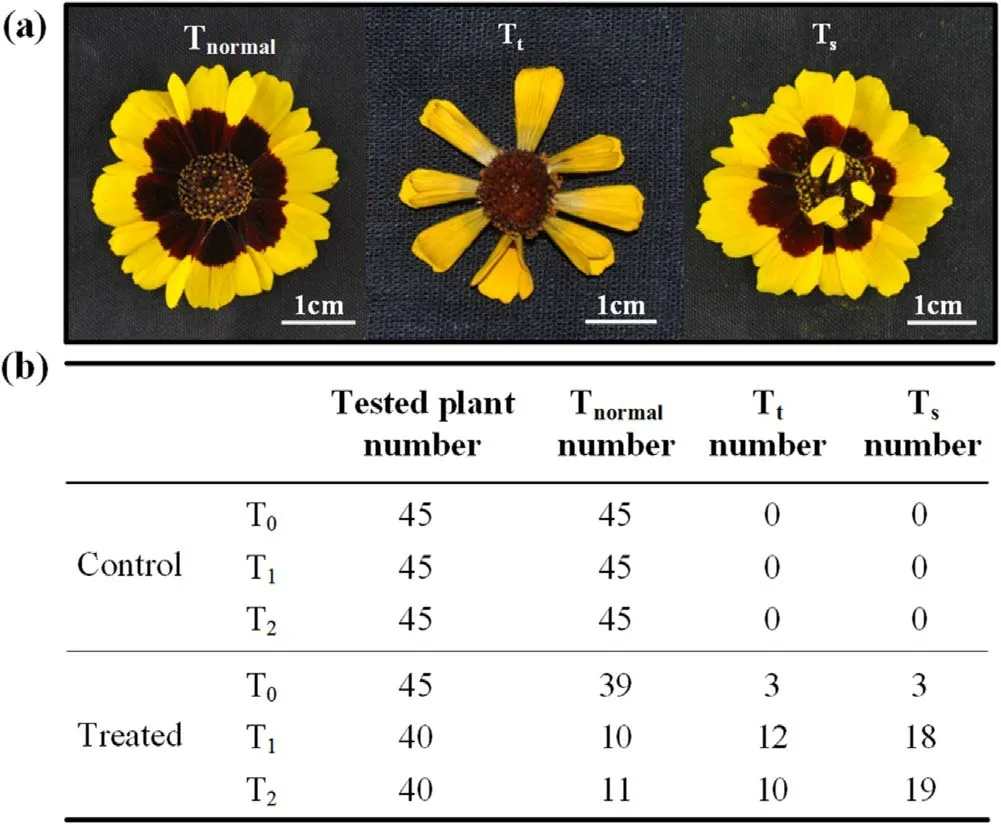
Figure 16.Mutation results of the Coreopsis. tinctoria Nutt. seeds after being treated by the ARTP-P machine.(a)Flower appearances,(b) number of each appearance in different generations.
To demonstrate the effectiveness of plant mutagenesis by the plasma treatment using the ARTP-P machine, a typical example using Coreopsis tinctoria Nutt. seeds is conducted.The experimental results show that, after irradiation by the ARTP-P machine,not only the seed germination potential and rate are improved [90], but also the flower appearances are remarkably changed,as shown in figure 16.In this section,45 Coreopsis tinctoria Nutt. seeds are treated to examine the mutagenesis by the ARTP-P machine and another 45 seeds are not treated, as a control group. The treated and untreated seeds are germinated on the filter paper for seven days. They are then transferred into nutrition bowls containing a mixture of vermiculite and nutrient soil (volume proportion is 1:1).The planting temperature, intensity of the illuminance and photoperiod are 295 K, 36.0 μmol/(m2·s) and 14 h per day,respectively. Under such conditions, these seedlings are cultivated for 40 days, and transplanted into fields. In order to avoid hybridization, the seeds after the plasma treatment and in the control group are planted separately until they flowered.
As shown in figure 16(a), there are three kinds of flower appearances, where normal flowers (named Tnormal) are developed from Coreopsis tinctoria Nutt.seeds of the control group,while the Ligulate petal tubular flowers(named Tt)and Stamen petaloid flowers (named Ts) are new ones emerging from the mutated seeds.Figure 16(b)lists the numbers of the three flower appearances in the three generations (T0, T1and T2) of the control group and the plasma-treated group. The flowers that develop from the control/treated seeds are called Generation T0,and the ones that develop from seeds collected among T0are called Generation T1. Similarly, we obtain Generation T2from T1. The plant numbers of Generation T0for the control group and plasma-treated group are both 45.As shown in figure 16(b),after the ARTP-P treatment,Ttand Tsfirst appear in Generation T0, and can be kept in the following two generations. This indicates that the ARTP-P machine treatment leads to heritable changes in the gene sequence that governs the flower appearances.
Since there is increasing concern regarding the biological safety issues of the plasma-induced effects [91], there are some aspects that need to be emphasized here. Genetically modified organisms (GMOs) are organisms whose genes are altered by genetic engineering techniques, and the first step of genetic engineering is always to artificially decide which gene is going to be modified, instead of a random gene modification [92]. The appearance of GMOs has led to a safety debate, while as a random mutagenesis,genome mutation with the aid of the ARTP jet is a non-GMO method[93,94].Therefore,mutated plants in the treated groups, in our opinion, should be classified as nongenetically-modified organisms(non-GMOs),and thus,should be biologically safe. In addition, although the preliminary results prove that the treatment of the plant seeds by the CAP jet issued from the ARTP-P machine has mutation effects on the plant flower appearances, due to the rather long cultivation periods of plants, further investigations concerning the mutation results for various kinds of plants,and the other features,e.g.the growth and yield parameters of the plasma-treated plants in different generations, are indispensable for providing more genetic evidence and for identifying genetic stability in the subsequent generations.
Finally, we hope to emphasize that, although the helium CAP jet treatment on Coreopsis tinctoria Nutt. seeds has resulted in an obvious change in flower appearance, it is required that CAP jets are produced using cheaper gases,e.g.argon, nitrogen, or even air, from the aspect of actual applications, due to the high cost of helium. Our previous studies have shown that the RF glow discharges using argon, nitrogen, air or their mixture as the plasma forming gas can be successfully produced and stably sustained with a watercooled bare-metallic electrode configuration, as that used in the present ARTP-P machine with the aid of the induced gas approach [80, 95, 96] or under an intensified local electric field[97],and our preliminary studies have shown that the RF CAPs generated using other gases can also have mutation effects on microorganisms. However,many aspects still need to be considered in order to obtain good mutation results for different plants with varying plasma-forming gases, from helium to argon, nitrogen, air or other gas mixtures. It is not only studies of plasma physics that are necessary to obtain steady discharges using different gases with the desired plasma parameters for plant mutation, e.g. concentrations of chemically reactive species, gas temperatures and electron energies, but studies of biochemical engineering are also indispensable, concerning the action mechanisms and effects of various plasma sources on different plants.
4. Conclusions
In this paper, we first review the state of the art of plant treatment by AP-DBD plasmas,and then introduce an ARTPP prototype for mutation breeding of plant seeds. The major conclusions are as follows:
(i) CAP has been widely confirmed to be a rapid,economic and environmentally-friendly tool for treating plants to promote growth performances, such as seed germination,seedling height and ultimately yield,as well as for controlling and curing plant diseases. CAP treatment issued by AP-DBDs can be sorted into direct and indirect treatment according to whether the plasmas contact the plants directly or not. The abundant ROS and RNS in the gas phase plasmas or the PAW play a key role during the plasma treatment process.
(ii) A newly-designed prototype, ARTP-P mutation breeding machine for plant seeds with a multi-plate-electrode generator as the core part,is proposed in this study.The physical experimental results show that this device can produce a large-area uniform RF CAP jet with low gas temperatures and high concentrations of chemically reactive species. The mortality test of Escherichia coli further demonstrates the plasma treatment homogeneity.Then, the conducted typical plasma mutation case for the Coreopsis tinctoria Nutt.seeds proves preliminarily that the ARTP-P machine is a powerful and prospective tool for the mutation breeding of plant seeds.
This newly-developed ARTP-P mutation breeding machine may become a platform for systematic research on plasma mutation mechanisms and results for various plant seeds.The following investigations are of great importance in future research.
(i) Due to the very complex physical-chemical processes during the CAP treatment of plant seeds, systematic experimental and numerical studies are indispensable for capturing the spatiotemporal evolutions of the energetic species concentrations in the gas phase of the plasma jet,for revealing the plasma jet-plant tissue interaction mechanisms,and for providing genetic evidence to identify the plant genetic stability with multiple generations.
(ii) From the point of view of actual applications, on the one hand,various configurations of discharge cells need to be designed carefully in future studies to obtain good plasma treatment results with irregular morphologies of various plant seeds. On the other hand, it is crucial to replace helium with other gases,e.g.argon, nitrogen or air,as the plasma working gas to reduce the capital cost of the mutation process.
(iii) It is very important to establish the relationship between the operating parameters,e.g.the chemical composition and flow rate of the plasma working gas, the discharge voltage and the power input,the action distance and the treatment time of the plasma jet, etc, on the mutation mechanisms and results of various plant seeds. This would form a parametric database for the mutation optimization of plant seeds using the ARTP-P mutation breeding machine, and would provide guidance for plant mutation using other types of plasma sources.
Acknowledgments
This work has been supported by the National Key Research and Development Program of China(No.2016YFD0102106)and National Natural Science Foundation of China (Nos.11475103, 21627812).
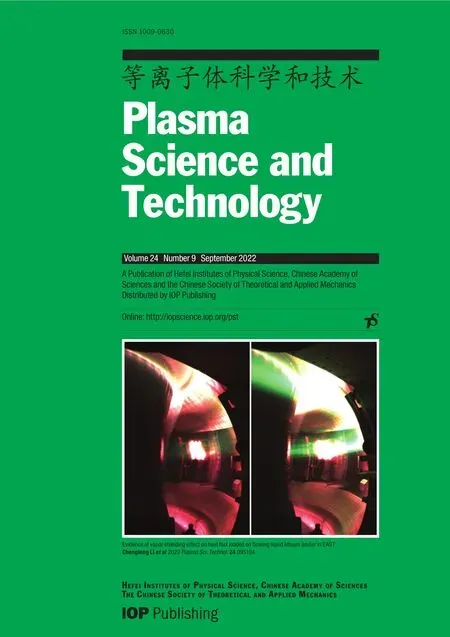 Plasma Science and Technology2022年9期
Plasma Science and Technology2022年9期
- Plasma Science and Technology的其它文章
- Degradation of tiamulin by a packed bed dielectric barrier plasma combined with TiO2 catalyst
- Improvement of the spreading effect of atmospheric pressure microplasma jet treatment through shielding-gas-controlled focusing
- Efficient direction-independent fog harvesting using a corona discharge device with a multi-electrode structure
- Experimental study on surface arc plasma actuation-based hypersonic boundary layer transition flow control
- Microchannel cooling technique for dissipating high heat flux on W/Cu flat-type mock-up for EAST divertor
- Implementation and application of PyNE sub-voxel R2S for shutdown dose rate analysis
